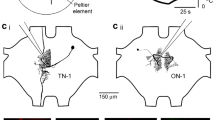Summary
-
1.
Removing the anterior tympanic membrane of the tettigoniidCaedicia simplex did not significantly alter either the tuning or the intensity-response characteristics of individual auditory fibers recorded in the leg nerve (Figs. 2 and 3). However, this operation did make the auditory sensilla in the crista acustica accessible for physiological recording.
-
2.
The physiological responses of individual auditory receptors in the crista acustica have been recorded and the frequency-threshold characteristics of identified sensilla have been measured for sound frequencies between 1 kHz and 40 kHz.
-
3.
In response to an acoustic stimulus a slow hyperpolarising potential (1–2 mV), lasting the duration of the tone and superimposed hyperpolarising spike potentials (2–4 mV) were recorded in the attachment cell of the sensillum (Fig. 4A). In two of the 28 sensilla from which recordings were obtained, depolarising spike potentials were recorded superimposed on the hyperpolarising potential (Fig. 4B). On rare occasions, depolarising spike potentials were recorded in the absence of any slow potential. Lucifer Yellow was successfully injected into the attachment cell of a sensillum only when the slow potential was recorded (Fig. 6).
-
4.
Each sensillum has a typical V shaped tuning curve with the most sensitive sensilla tuned to sound frequencies between 7 kHz and 18 kHz (Figs. 7 and 8). The sensilla of the crista acustica are tonotopically organised with the more proximal receptors tuned to the lower sound frequencies (Figs. 6–8). The frequencies of optimal sensitivity of adjacent sensilla are separated by an interval of approximately 1 kHz (Fig. 8).
Similar content being viewed by others
References
Autrum H (1940) Über Lautäußerungen und Schallwahrnehmung bei Arthropoden II. Das Richtungshören vonLocusta und Versuch einer Hörtheorie für Tympanalorgane vom Locustidentyp. Z Vergl Physiol 28:326–352
Autrum H (1941) Über Gehör und Erschütterungssinn bei Locustiden. Z Vergl Physiol 28:580–637
Fielden A (1960) Transmission through the last abdominal ganglion of the dragonfly nymph,Anax Imperator. J Exp Biol 37(4):832–844
Graber V (1876) Die tympanalen Sinnesapparate der Orthopteren. Denkschr Akad (Wien) Math Naturwiss Kl (Abt II) 36:1–140
Gray EG (1960) The fine structure of the insect ear. Philos Trans R Soc Lond [Biol] 243:75–94
Hill KG, Oldfield BP (1981) Auditory function in tettigoniidae (Orthoptera: Ensifera). J Comp Physiol 142:169–180
Kalmring K, Lewis B, Eichendorf A (1978) The physiological characteristics of the primary sensory neurons of the complex tibial organ ofDecticus verrucivorus L. (Orthoptera: Tettigoniidae). J Comp Physiol 127:109–121
Nocke H (1975) Physical and physiological properties of the tettigoniid (“grasshopper”) ear. J Comp Physiol 100:25–57
Rheinlaender J (1975) Transmission of acoustic information at three neuronal levels in the auditory system ofDecticus verrucivorus (Tettigoniidae: Orthoptera). J Comp Physiol 97:1–53
Schumacher R (1979) Zur funktioneilen Morphologie des auditiven Systems der Laubheuschrecken (Orthoptera: Tettigoniidae). Entomol Gen 5:321–356
Schwabe J (1906) Beiträge zur Morphologie und Histologie der tympanalen Sinnesapparate der Orthoptera. Zoologica (Stuttgart) 50:1–154
Suga N (1960) Peripheral mechanism of hearing in locust. Jpn J Physiol 10:533–546
Thomas MV (1977) Microelectrode amplifier with improved method of input-capacitance neutralization. Med Biol Eng Comput 15:450–454
Zhantiev RD (1971) Frequency characteristics of tympanal organs in grasshoppers (Orthoptera: Tettigoniidae). Zool Zh 50:507–514
Zhantiev RD, Korsunovskaya OS (1978) Morphofunctional organization of tympanal organs inTettigonia cantons (Orthoptera: Tettigoniidae). Zool Zh 57:1012–1016
Author information
Authors and Affiliations
Rights and permissions
About this article
Cite this article
Oldfield, B.P. Tonotopic organisation of auditory receptors in tettigoniidae (Orthoptera: Ensifera). J. Comp. Physiol. 147, 461–469 (1982). https://doi.org/10.1007/BF00612011
Accepted:
Issue Date:
DOI: https://doi.org/10.1007/BF00612011




